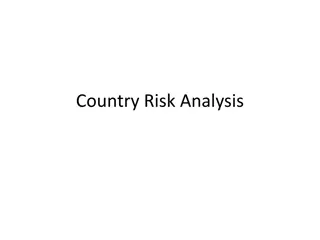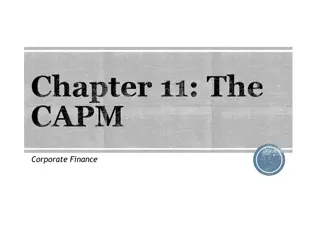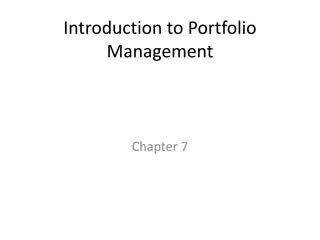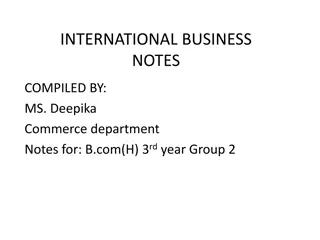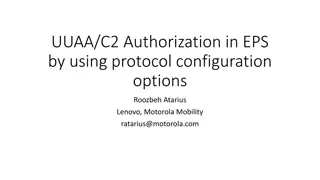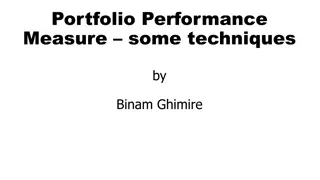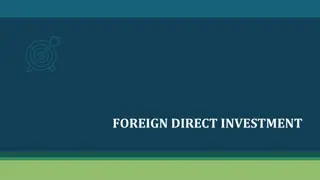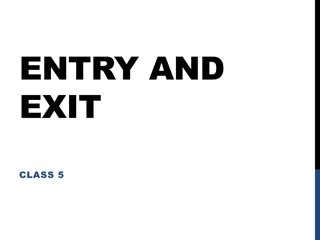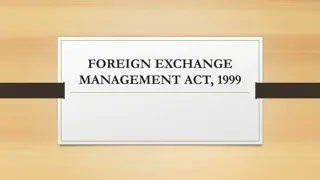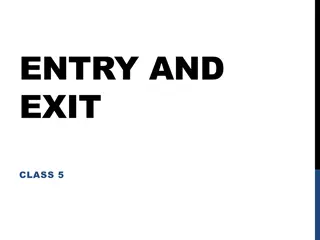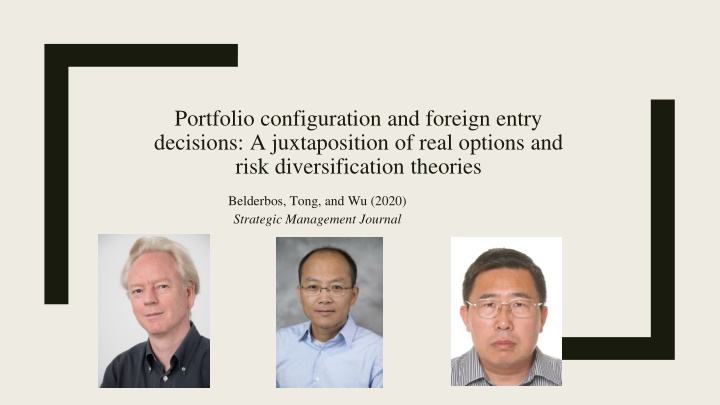
Portfolio Configuration and Foreign Entry Decisions: Real Options vs Risk Diversification
This study explores how multinational firms make foreign entry decisions by analyzing the interplay between portfolio configuration, real options theory, and risk diversification theory. It investigates how firms' flexibility considerations influence their entry choices and the moderating factors affecting those considerations.
Download Presentation

Please find below an Image/Link to download the presentation.
The content on the website is provided AS IS for your information and personal use only. It may not be sold, licensed, or shared on other websites without obtaining consent from the author. If you encounter any issues during the download, it is possible that the publisher has removed the file from their server.
You are allowed to download the files provided on this website for personal or commercial use, subject to the condition that they are used lawfully. All files are the property of their respective owners.
The content on the website is provided AS IS for your information and personal use only. It may not be sold, licensed, or shared on other websites without obtaining consent from the author.
E N D
Presentation Transcript
Portfolio configuration and foreign entry decisions: A juxtaposition of real options and risk diversification theories Belderbos, Tong, and Wu (2020) Strategic Management Journal
Introduction Research Gap in explaining multinational firms foreign entry decision: prior research has primarily treated each entry as an independent event and has rarely considered that entry decisions may be affected by how firms existing portfolio of overseas affiliates is configured. Multinational firms take into account the contribution that an entry into a new location makes toward increasing the operational flexibility of their manufacturing affiliate portfolios. Real options view + risk diversification theory: authors argue that firm s new entries depend on characteristics of the configuration of their existing affiliate portfolios. Options to switch: Multinational enterprises (MNEs) gain the enhanced options to switch value- added activities across internationally dispersed affiliates in case of diverging developments in labor and other input cost (Kogut & Kulatilaka, 1994). Research Question: how do flexibility considerations affect firms foreign entry decisions in the first place and what are the moderating factors for such considerations?
Literature and Hypotheses Risk and uncertainty: real options theory offers a more formal, finer-grained approach to firm behavior under uncertainty than risk diversification theory, which focuses on risk reduction logic. Differences between the two related theories: whereas international diversification theory emphasizes minimizing the risk of expected return or the narrowing of the distribution of possible outcomes, real options theory highlights the capture of dynamic efficiency gains and upside potential by creating and exercising options at the right place at the right time. Correlations and Option Value The value of switching options in labor cost: Labor costs development is a particularly critical consideration in international manufacturing. Efficiency driven FDI: minimize (production) costs Decrease redundancy: decrease correlations in labor costs among the countries in which the firm operates Such switching opportunities are most salient if the environmental conditions in the various host countries in which firms operate do not develop in tune, but are uncorrelated, or negatively correlated. Hypothesis (H1) ( Flexibility increase ) Multinational firms are more likely to enter a new host country, the less labor cost developments in that host country are correlated with labor cost developments in the existing foreign affiliate portfolio.
Literature and Hypotheses The addition of a new location to the portfolio influences switching options through 1) change in portfolio-level correlations in labor costs; and 2) change in portfolio-level dispersion in labor cost levels. Switching options and labor cost levels differences. The dispersion in labor cost levels in the different countries in which the firm operates affiliates can shape the effective opportunities for international production shifting. In the case of very low dispersion, there will be relatively little to gain in switching. In the case of a very high dispersion, the likelihood that for a given divergence in labor cost growth, there will be a meaningful change and reversal in labor cost levels calling for switching, is small. different country locations are not effective substitutes (large differences in worker skills, productivity, production techniques, and product quality. ? switching costs in terms of additional training or adaptations in the production process are overly high. A change in the portfolio-level dispersion as a moderator: At low levels of labor cost dispersion increase due to an entry, switching opportunities are enhanced, as the increase in dispersion creates larger benefits of switching. When the dispersion increase passes a certain threshold, switching opportunities are likely to decrease because this dispersion implies differences in production techniques and skill levels that are too large to allow for flexibility. Hypothesis (H2) The increase in labor cost level dispersion among the countries in the affiliate portfolio due to the entry into a host country moderates the positive impact of flexibility increase on firms' propensity to enter the host country [Hypothesis (H1)] in an inverted U-shaped manner.
Literature and Hypotheses Cost or price considerations involved in obtaining an option: partial shutdowns and startups, changing logistics and labor contracts, and commitment of managerial time and attention. The ease of relocating production across affiliates is related to firms product diversification (similarity in specific assets, machinery, and facilities) Hypothesis (H3) The positive impact of flexibility increase on firms' propensity to enter a host country [Hypothesis (H1)] is negatively moderated by product diversification in firms affiliate portfolios. Switching opportunities consideration: the opportunity to switch may not increase if the focal country's labor cost exhibits little fluctuation such that major changes in relative labor costs are unlikely to occur. Decreasing marginal effect: When labor cost volatility in a focal country is already high, the additional volatility will provide fewer additional switching opportunities. Hypothesis (H4) Multinational firms are more likely to enter a new host country, the higher the labor cost volatility in that host country; the marginal effect of labor cost volatility declines at higher levels of volatility.
Summary of Hypotheses product diversification in firm s affiliate portfolios -H3 + Likelihood of entry to new host country Flexibility H1 -H2 increase in labor cost level dispersion among the countries in the affiliate portfolio *marginal effect declines + the labor cost volatility in host country Likelihood of entry to new host country H4
Data and Method Sample firms: Japanese publicly listed multinational firms in manufacturing industries during 1989 2006 Variables and measures: Market entry: a binary variable, which takes the value one when the firm enters a country, and zero otherwise. Labor costs correlation decrease (Flexibility increase): The reduction in labor cost correlation in the foreign affiliate portfolio due to the addition of a potential host country to the portfolio Labor cost level dispersion increase: the increase in the dispersion of labor cost levels in the firm's portfolio of affiliates due to the addition of a new host country to the portfolio The relatedness-weighted diversification: (1 relatedness) * the number of industries in the portfolio Three salient resource characteristics for relatedness: capital intensity (total capital/employees), material intensity (material costs/ sales), and R&D intensity Host country labor cost volatility: The standard deviation of labor cost over a five-year period (from t 4 to t) for the focal country Control Variables: Demand correlation reduction; Demand volatility reduction; Political risk; The level of labor cost in the host country; Labor cost growth in the host country; the logarithm of GDP; GDP growth; the number of existing Japanese manufacturing affiliates in the country; the number of existing affiliates in the same industry; Host country demand uncertainty; Prior affiliate investment; the interaction between prior affiliate investment and flexibility increase; Firm size; Tobin s q; Export ratio; International manufacturing experience; Sales affiliate; Multinationality; a full set of host country, industry, and year fixed effects
Results Corroborated with H1 ~H4 Corroborated with traditional risk diversification theories
Discussion Both real options theory and traditional risk diversification have important roles to play in explaining firms' foreign entry decision from flexibility (either operational and demand) Contributions: Contributes to the real options literature by identifying several important moderating factors of the influence of flexibility (switching options) considerations on firms market entry decisions. Adds to the literature adopting a portfolio approach to examine international market entry and exit by taking into account that new affiliates can be complementary or redundant in the firm's affiliate portfolio. Contributes to literature on multinationality and performance by adding portfolio-level switching options considerations



